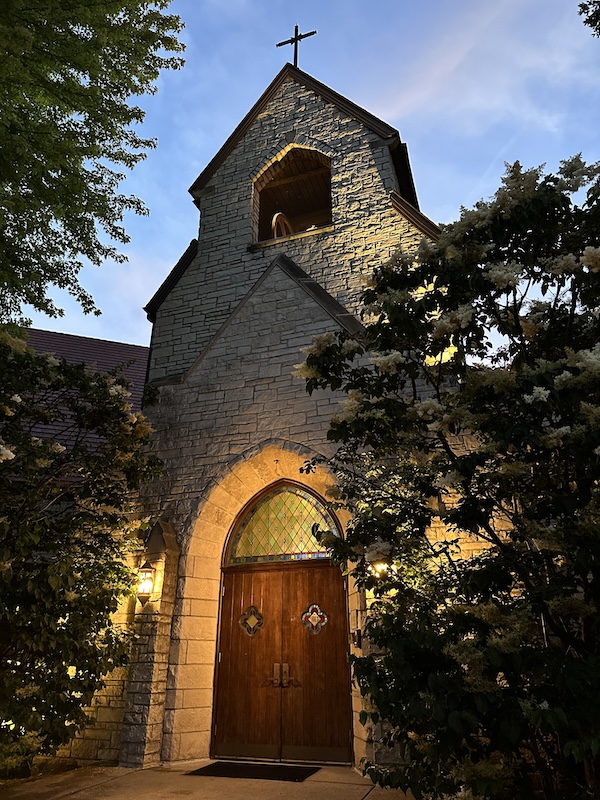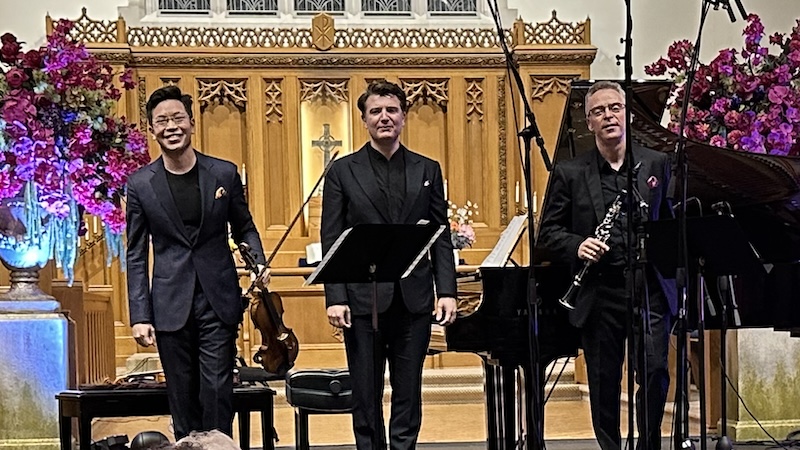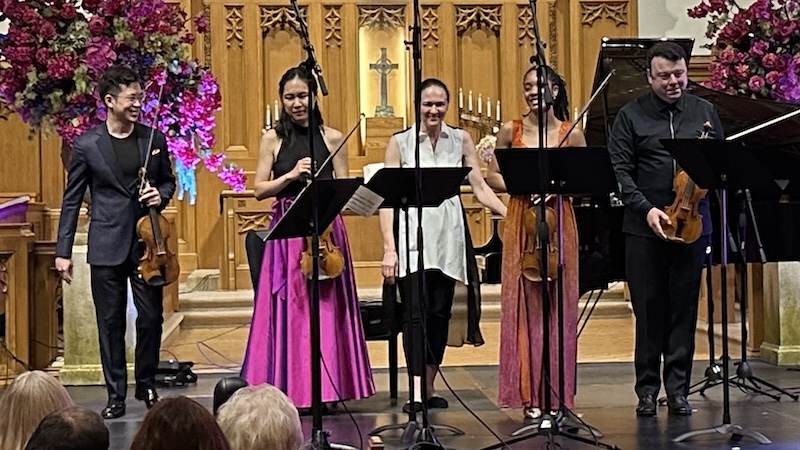Review: Highlights from North Shore Chamber Music Festival, Days 2 and 3 – Violinist.com
by July 2, 2024It was a picture-perfect evening in early June – the sun was getting low and the wild din of the 17-year cicadas was beginning to subside in the trees outside the Village Presbyterian Church in Northbrook, just north of Chicago.

The Village Presbyterian Church of Northbrook.
As I waited to be seated on the second evening of the North Shore Chamber Music Festival, I was talking to two women. One, Yancidara Davila, had traveled from here from Mexico to see the festival and also to help run it. The other had traveled from Taiwan, primarily to hear violinist Paul Huang play. I was getting used to this – people were here from all over the place.
The second night’s concert was called “The American – tribute to Benny Goodman,” and it tied together works by Gershwin, Dvorak, Bartok and Goodman. (View a video of the concert here on their website.) It was a melting pot of a program for a melting pot of a festival. As violinist Vadim Gluzman said in his introductory remarks, “on stage today we will have representatives of more than a dozen nationalities and ethnic backgrounds – from China, Taiwan, South Korea, Germany, Italy, Latvia, Ukraine, Israel. We have a young lady who was born in Australia, she’s Armenian, and she grew up in Chicago. It does not get more international!”

Musicians of the 2024 North Shore Chamber Music Competition.
Of course Benny Goodman was a clarinetist – born in Chicago in 1909, he was considered the “King of Swing.” Thus this concert primarily featured the talented and versatile clarinetist Ilya Shterenberg, who has performed every concert with the NSCMF since the beginning. It culminated with a string ensemble comprised of NSCMF artists doubling as a “big band,” while Shterenberg performed lively favorites such as “Sweet Georgia Brown” and “Sing, Sing, Sing.” The arrangements by Ljova – the violist and composer Lev Zhurbin – were a big audience hit.
But what does Benny Goodman have to do with, for example, Bela Bartok? It was something I did not know: back in 1938, Goodman, along with the violinist Joseph Szigeti, commissioned Bartok to write a piece for violin, clarinet and piano. This concert provided the perfect excuse to program that seldom-played work, called “Contrasts.”
At the time he wrote the piece, Bartok had never used a wind instrument in a chamber work. Instead of trying to blend the sounds of instruments, Bartok went the opposite direction in this composition. In combining percussion, wind and stringed instruments, Ilya explained that “Bartok sought to show the contrasts, thus the title of the piece.” (The original 1940 recording is worth a listen – it featured Goodman, Szigeti and Bartok himself on piano!)
With pianist Alessio Bax joining Ilya and violinist Paul Huang, this was a real treat – arguably the artistic pinnacle of the festival (though it didn’t get the standing ovation that the rollicking “Sing, Sing, Sing” did at the end of the concert!) The work is in three movements “Verbunkos” (Recruiting Dance), Pihinö (Relaxation) and “Sebes” (Fast Dance), and it requires two clarinets and two violins – one tuned normally and one scordatura, used to great effect in the last movement, which sounds a lot like “Danse Macabre” as it begins, then spins into a dizzy dance, which these musicians took at a thrilling speed. The second movement “Relaxation” was also a highlight, with the violin and clarinet lines melting together, despite the clashing harmonics and tonal qualities of the instruments. Ilya had described it as “the dark music of night – even with some creatures crawling in the dark” – Bax made the little creatures come to life, with the little utterances so perfectly placed in the piano.

Violinist Paul Huang, pianist Alessio Bax and clarinetist Ilya Shterenberg.
The program also featured Dvorak’s “American” Quintet (not quartet, as is so often played) with Gluzman, violinist Danbi Um, violists Jan Grüning and Katie Liu and cellist Ani Aznavoorian.
A recent book called Dvorak’s Prophecy tells the fascinating story of how Dvorak contributed to the development of classical music in America, with this travels here in the late 19th century, absorbing the diverse musical landscape, including the music of native and Black people. Introducing the quintet before they performed, violist Jan Grüning also referenced that history, adding that “to me, this work is not just a result of cultural sharing, but it radiates that idea.”
The quintet was written after his “American” quartet – while Dvorak was in Spillville, Iowa – with instrumentation like a quartet but with an extra viola. It has a lot of the same harmonic language as the quartet, but a little more robust with that added viola. One highlight was a weepy cello solo in the third movement, which Ani played with wonderful expression and a long sense of the musical line.
The Three Preludes, originally written for piano, were arranged for clarinet, violin, viola, cello and double bass by the clarinetist Bixby Kennedy. Played by Ilya, Danbi, Jan, Ani and bassist Kurt Muroki, this configuration worked best in the busy last movement, which, when spread across the five instruments, painted a musical picture – something like the bustle of early 20th century New York – that said something a little more expansive than the original instrumentation.
The Final Night
The final evening of the NSCMF celebrated the violin, with four short violin works by Tchaikovsky, played each by a separate violinist with pianist Alessio Bax, followed by Ludwig Wilhelm Maurer’s “Concertante” for four violins and piano (this time with pianist Angela Yoffe.) After the intermission was a work by Max Bruch – most famous for his first violin concerto – his String Symphony, Opus Posthumous.
The consecutive Tchaikovsky performances also felt like a beauty pageant for the instrument itself, as we heard four different rare instruments in a row: Vadim on the 1690 “ex-Auer” Stradivari, Njioma Grevious playing a Pietro Guarneri, Danbi on the the 1683 “ex-Petcheks” Nicolo Amati, and then Paul Huang on the 1742 “ex-Wieniawski” Guarneri del Gesù. (The Yamaha piano was played beautifully by Alessio, but the instrument’s sound didn’t quite measure up to these fine instruments!)
In fact, Vadim mentioned that he was playing the “Meditation Op. 42” – “which was written for this very violin,” as it was originally the middle movement to the violin concerto, which had been intended for the violinist Leopold Auer. And indeed, the sound was very rich, Vadim playing with a wide and rapid vibrato, his tone always shimmering.
Ngioma, the newest recipient of NSCMF’s Arkady Fomin Scholarship, showed a lovely sense of timing in the “Scherzo and Melody.” Danbi showcased the dark colors of her Amati violin in the Serenade Mélancolique, and Paul played the “Valse-Scherzo” with elegance, nuanced vibrato and a keen sense of the dance in this work.
When audience members were asked if they’d heard of Ludwig Wilhelm Maurer, only three hands went up. He was a German composer who lived and worked in Russia – and when his “Concertante” was premiered, it was reviewed by Tchaikovsky himself. Featuring all four violinists together, this was a celebration of the violin, with powerhouse sound, sometimes in full force together, sometimes in conversation in pairs or one-by-one.

Paul Huang, Danbi Um, Angela Yoffe, Ngioma Grevious and Vadim Gluzman.
Bruch’s three-movement “Sinfonia” was a fairly recent discovery – a long-lost score, found in 1996, revealed the composer’s final work, written during a time when his wife passed away. Performed on this occasion with four violins, two violas, a cello and bass, it was a sentimental but energetic work. The Adagio was perhaps my favorite movement – featuring a distinct and recurring rhythmic pattern – a bit ominous and funereal – interspersed with more songful and flowing sections.
All musicians in the festival returned to stage for a final number – a reprise of Benny Goodman’s “Sing, Sing, Sing,” to end with a little “dessert” and a big standing ovation.
You might also like:
- North Shore Chamber Music Festival 2024 Day 1: A Triumvirate of Talent
- Betty Haag and a New Generation of Violinists – NSCMF 2024
- Labor of Love: North Shore Chamber Music Festival Begins June 5
* * *
Enjoying Violinist.com? Click here to sign up for our free, bi-weekly email newsletter. And if you’ve already signed up, please invite your friends! Thank you.
A beautiful review! It sounds a wonderful festival, Laurie.
This article has been archived and is no longer accepting comments.
Violinist.com is made possible by…
Shar Music
Los Angeles Philharmonic
Violinist.com Shopping Guide
Larsen Strings
Corilon Violins
DYNAMO Strings
JR Judd Violins
Dimitri Musafia, Master Maker of Violin and Viola Cases
Pirastro Strings
Metzler Violin Shop
Southwest Strings
Bobelock Cases
Johnson String Instrument/Carriage House Violins
Bay Fine Strings Violin Shop
Jargar Strings
Fiddlerman.com
FiddlerShop
Violin Lab
Connolly
Barenreiter
Nazareth Gevorkian Violins
Laurie’s Books
Discover the best of Violinist.com in these collections of editor Laurie Niles’ exclusive interviews.
Violinist.com Interviews Volume 1, with introduction by Hilary Hahn
Violinist.com Interviews Volume 2, with introduction by Rachel Barton Pine
Subscribe

Leave a comment